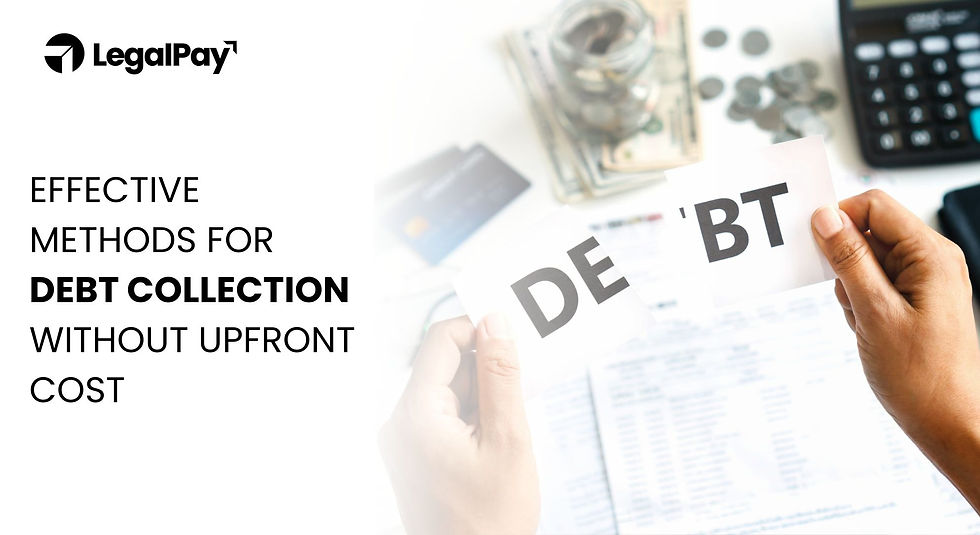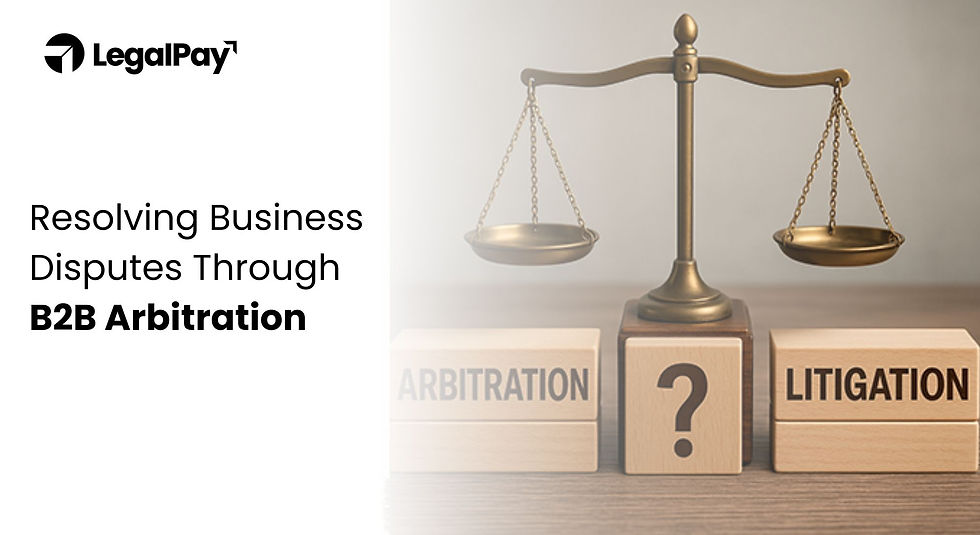EFFECTIVE METHODS FOR DEBT COLLECTION WITHOUT UPFRONT COST
- Manan Jain
- 22 hours ago
- 6 min read

Recovering unpaid debts is essential to any business’s financial stability, yet creditors often hesitate to pursue recovery due to perceived costs. Fortunately, several structured, no upfront cost strategies can help businesses recover dues effectively while preserving cash flow. By escalating efforts in a disciplined manner from internal follow ups to third party agencies to minimal cost legal actions, creditors can maximize recovery without significant expenditure. Research and industry data consistently show that most debts are resolved during pre legal stages when handled diligently and systematically, often without requiring litigation. Below is a comprehensive, corporate friendly guide to debt collection without upfront cost.
A. INTERNAL DEBT COLLECTION METHODS (NO UPFRONT COST)

Internal or first party collections use your own staff, communication tools and authority, with no external fees. They help maintain customer goodwill and allow full control over the process. The key is structured escalation backed by consistent documentation.
1. Telephone Calls and Payment Reminders
A regular call schedule weekly or bi weekly is often the first step after an invoice becomes overdue. Courteous but firm reminders help identify genuine issues and clear them immediately by sending documents during the call. Each commitment should be documented, and follow ups triggered automatically if deadlines lapse. Persistent but professional contact underscores seriousness and prevents debtors from becoming complacent.
2. Negotiation and Reconciliation Offers
If the debtor claims financial stress or disputes, a revised repayment plan or one time settlement may break deadlock. Such negotiations sometimes called reconciliation offers can include extended timelines, waiver of minor charges, or partial write offs in exchange for immediate payment. These arrangements must be recorded in writing through a settlement agreement or promissory note. This approach is particularly effective for retaining long term business relationships.
3. Formal Demand Letter on Letterhead
If informal nudges fail, a demand notice from your company adds gravity. It should outline the amount outstanding, invoice details, payment deadline, and consequences of non-payment such as escalation, legal action or service suspension. Sending it through registered or certified mail provides proof of notice. In commercial settings, a well drafted final demand letter often results in payment without further steps.
4. On Site Visits by Company Representative
A physical visit by a credit controller or accounts representative demonstrates seriousness. Representatives can carry documents, seek immediate response, and assess the debtor’s operational condition. Many businesses consider an in person visit essential for accounts that show persistent delinquency. This method only requires staff time and no external fees.
5. Escalation to Senior Management
If routine communication stalls, direct outreach from senior executives for example CFO to CFO or director to director can prompt quick resolution. Senior level conversations reposition the matter as a business obligation rather than a routine accounts receivable issue. This escalation typically precedes involvement of external agencies and signals that the company is preparing for formal action.
Across all internal steps, meticulous documentation is critical. It strengthens your negotiation position and creates admissible evidence if external agencies or courts become involved.
B. EXTERNAL COLLECTIONS VIA THIRD PARTY AGENCIES (NO WIN NO FEE)
If internal efforts fail, a collection agency can be engaged on a contingency basis commonly known as a no win no fee model. You pay nothing upfront; the agency earns a percentage only when they collect.
Contingency fees typically range from 10 percent to 30 percent for commercial debts depending on age and complexity. If nothing is recovered, you owe nothing.
How Third Party Agencies Increase Recovery
1. Persistent Skilled Contact
Agencies use trained professionals capable of applying firm but lawful pressure through phone calls, emails, letters and SMS. Debtors often respond more readily when communication comes from a third party.
2. Skip Tracing
If a debtor has moved or changed contact information, agencies use databases, credit records, public filings and specialized tools to locate them. Skip tracing is invaluable when a debtor goes silent.
3. Field Visits by Agency Representatives
Many agencies deploy field agents who conduct unannounced visits, often more effective than letters and calls. These visits can prompt immediate discussions or even same day collection. Focus should be on collection of either a partial payment or a post dated cheque.
C. MINIMAL COST LEGAL MEASURES
If both internal and external agency efforts fail or if the debtor firmly refuses to pay, legal escalation may be required. Litigation can be expensive, but certain legal tools provide strong leverage without significant upfront cost.
1. Legal Notice from an Attorney
A legal notice on a law firm’s letterhead is a powerful, low cost step. It cites contractual obligations, mentions applicable laws, demands payment within a specified period, and warns of imminent legal action. Debtors generally take legal notices seriously, especially in B2B relationships. Many disputes settle at this stage.
2. Litigation Funding (Zero Upfront Cost)
For large debts, third party litigation funders may finance the entire lawsuit including lawyer fees, court fees, and expert costs on a nonrecourse basis. If you lose, you pay nothing. This allows businesses to pursue strong high value claims without budget constraints. It is most suitable for substantial debts backed by strong documentation.
3. Pre Institution Mediation
Mediation is confidential, quicker than litigation, and legally encouraged in many jurisdictions. In India, mediation is mandatory before filing a commercial suit unless urgent relief is required. Mediation costs are minimal and often lead to structured settlements.
D. WHEN TO PROCEED TO LITIGATION OR ARBITRATION
Litigation should be a last resort due to cost and time, but the groundwork laid through earlier stages communications, demand notices, agency attempts, mediation creates a strong evidentiary foundation. The act of filing itself often triggers settlement, as many debtors wish to avoid public court records or enforcement action.
CONCLUSION
Recovering debts without upfront cost requires a tiered, strategic and disciplined approach:
Start with strong internal processes: calls, reminders, formal demand letters and management escalation.
If unresolved, engage a contingency based collection agency.
If needed, use low cost legal tools: legal notices, mediation, and litigation funding.
Most debts settle during earlier stages when handled professionally. By combining internal diligence, third party expertise and cost efficient legal tools, businesses can recover dues effectively while maintaining cash flow and minimizing financial risk.
Frequently Asked Questions (FAQs)
1. Are internal collection efforts really effective?
Yes. Regular calls, timely reminders, and formal demand letters create sustained pressure while preserving the business relationship. In a majority of cases, these steps prompt payment without requiring escalation. However, many companies find that internal teams struggle to maintain consistent follow ups. This is where LegalPay’s Stage 1 recovery services complement in house efforts by providing structured communication, professional follow ups, and legally compliant notice processes that significantly increase response rates even before any legal escalation.
2. Why is documentation important during internal recovery?
Comprehensive documentation such as emails, call logs, payment commitments, and invoice records significantly strengthens your position. It not only supports negotiations but also becomes crucial evidence if the case moves to an external agency, mediation, arbitration, or court. Well-kept records improve credibility and speed up dispute resolution.
With LegalPay’s Stage 1, every communication like notices, field visit updates, debtor responses, commitments, and delivery proofs is systematically documented. This creates a complete evidentiary trail that can be relied upon for legal escalation or swift settlements, reducing disputes and speeding up resolution.
3. What is a no-win, no-fee collection agency?
A no-win, no-fee agency is a third-party collector that charges only upon successful recovery. Their contingency fee typically falls between 10% and 30%, depending on the age, nature, and complexity of the debt. If the agency does not recover anything, you owe zero upfront costs and pay nothing. LegalPay operates on a similar contingency driven model for many cases, making Stage 1 recovery a cost effective no risk first step for businesses seeking quick results without additional financial burden.
4. How do collection agencies improve recovery rates?
Collection agencies add structured intensity and expertise to the process through:
Skilled and persistent follow-ups across calls, emails, and written communication
Skip tracing to locate debtors who have changed numbers, addresses, or gone silent
Field visits by trained representatives, which often prompt immediate dialogue or payment commitments.
LegalPay’s Stage 1 service integrates all these elements by combining expert communication, legal notice issuance, on ground field collections, and compliance backed processes. This multi layered approach often delivers faster responses and improved recovery outcomes compared to routine internal communication alone. When internal and Stage 1 efforts do not resolve the matter, LegalPay can escalate the case to Pre Institution Mediation and, if necessary, litigation, ensuring end to end recovery capability under one platform.




Comments